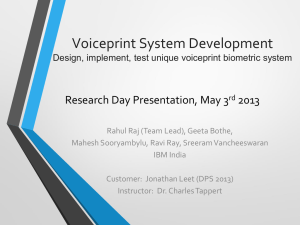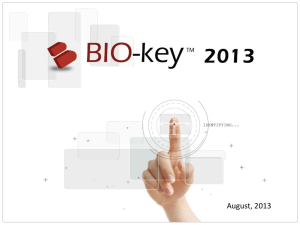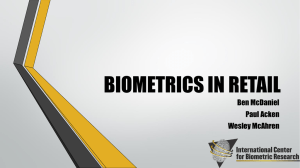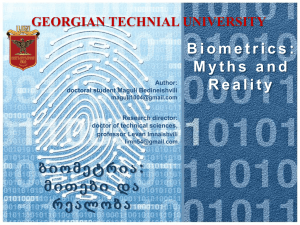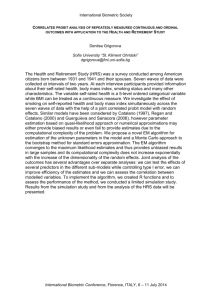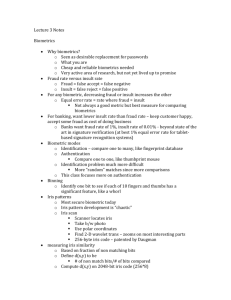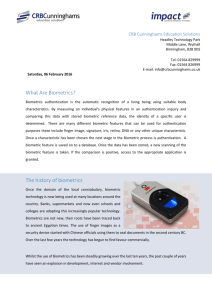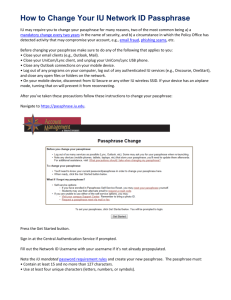Voiceprint Biometric Authentication System
advertisement
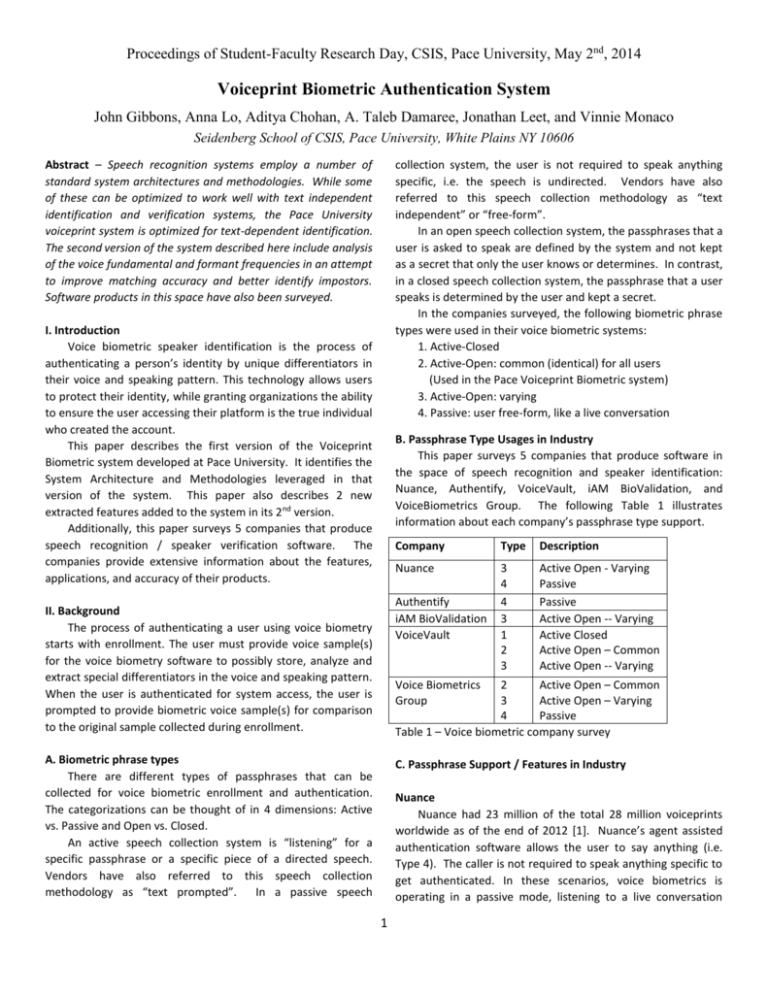
Proceedings of Student-Faculty Research Day, CSIS, Pace University, May 2nd, 2014 Voiceprint Biometric Authentication System John Gibbons, Anna Lo, Aditya Chohan, A. Taleb Damaree, Jonathan Leet, and Vinnie Monaco Seidenberg School of CSIS, Pace University, White Plains NY 10606 Abstract – Speech recognition systems employ a number of standard system architectures and methodologies. While some of these can be optimized to work well with text independent identification and verification systems, the Pace University voiceprint system is optimized for text-dependent identification. The second version of the system described here include analysis of the voice fundamental and formant frequencies in an attempt to improve matching accuracy and better identify impostors. Software products in this space have also been surveyed. collection system, the user is not required to speak anything specific, i.e. the speech is undirected. Vendors have also referred to this speech collection methodology as “text independent” or “free-form”. In an open speech collection system, the passphrases that a user is asked to speak are defined by the system and not kept as a secret that only the user knows or determines. In contrast, in a closed speech collection system, the passphrase that a user speaks is determined by the user and kept a secret. In the companies surveyed, the following biometric phrase types were used in their voice biometric systems: 1. Active-Closed 2. Active-Open: common (identical) for all users (Used in the Pace Voiceprint Biometric system) 3. Active-Open: varying 4. Passive: user free-form, like a live conversation I. Introduction Voice biometric speaker identification is the process of authenticating a person’s identity by unique differentiators in their voice and speaking pattern. This technology allows users to protect their identity, while granting organizations the ability to ensure the user accessing their platform is the true individual who created the account. This paper describes the first version of the Voiceprint Biometric system developed at Pace University. It identifies the System Architecture and Methodologies leveraged in that version of the system. This paper also describes 2 new extracted features added to the system in its 2 nd version. Additionally, this paper surveys 5 companies that produce speech recognition / speaker verification software. The companies provide extensive information about the features, applications, and accuracy of their products. B. Passphrase Type Usages in Industry This paper surveys 5 companies that produce software in the space of speech recognition and speaker identification: Nuance, Authentify, VoiceVault, iAM BioValidation, and VoiceBiometrics Group. The following Table 1 illustrates information about each company’s passphrase type support. Company Type Description Nuance 3 4 4 3 1 2 3 Active Open - Varying Passive Passive Active Open -- Varying Active Closed Active Open – Common Active Open -- Varying Authentify iAM BioValidation VoiceVault II. Background The process of authenticating a user using voice biometry starts with enrollment. The user must provide voice sample(s) for the voice biometry software to possibly store, analyze and extract special differentiators in the voice and speaking pattern. When the user is authenticated for system access, the user is prompted to provide biometric voice sample(s) for comparison to the original sample collected during enrollment. Voice Biometrics Group 2 Active Open – Common 3 Active Open – Varying 4 Passive Table 1 – Voice biometric company survey A. Biometric phrase types There are different types of passphrases that can be collected for voice biometric enrollment and authentication. The categorizations can be thought of in 4 dimensions: Active vs. Passive and Open vs. Closed. An active speech collection system is “listening” for a specific passphrase or a specific piece of a directed speech. Vendors have also referred to this speech collection methodology as “text prompted”. In a passive speech C. Passphrase Support / Features in Industry Nuance Nuance had 23 million of the total 28 million voiceprints worldwide as of the end of 2012 [1]. Nuance’s agent assisted authentication software allows the user to say anything (i.e. Type 4). The caller is not required to speak anything specific to get authenticated. In these scenarios, voice biometrics is operating in a passive mode, listening to a live conversation 1 with an agent and then providing the agent with a confirmation of identity on the agent’s computer screen. Another Nuance product operates in active mode. Nuance’s IVR Automated Authentication, Mobile Application Authentication has the caller recite a passphrase like: “At ABC Company, my voice is my password”. See Figure 1. The company TD Waterhouse makes use of Nuance and uses a passphrase: 10-digit phone number + date: month + day. In other words, this Nuance product uses Type 3 passphrases. [2] Figure 2 – Sample Passphrase used by Authentify iAM BioValidation iAM BioValiation is a product provided by the American Safety Council (ASC). “The American Safety Council is a market leader in the engineering, authoring and delivery of e-Learning training solutions to address transportation and workplace safety, testing, and medical continuing education on behalf of government, institutions of higher learning, business and industry, as well as individual clients. ASC currently implements voice or keystroke biometrics that meets the requirements of several organizations including The New York Department of Motor Vehicles, The New Jersey Motor Vehicle Commission, The University of California at San Diego, AAA, The Florida Department of Highway Safety and Motor Vehicles and more.” [3] iAM BioValidation employs a model of voiceprint comparison known as text directed speech (i.e. Type 3). Specifically for iAM BioValidation, by default the system prompts for training and authorization using randomized sets of numbers. For example in Figure 3, the user calls the listed phone number and reads the appropriate line when prompted. Figure 1 – Sample Passphrase used by Nuance Authentify Authentify claims that they are the worldwide leader in “phone-based out-of-band authentication”. Out-of-Band Authentication is the use of two separate networks working simultaneously to authenticate a user. Voice authentication through a phone is carried out to verify the identity of the user involved in a web transaction. [2] It employs a model of voiceprint comparison known as text independent directed speech (i.e. Type 4). With many users being from different cultures or having different accents or comfort levels with vocabulary, numbers are the most accessible way to get consistent voice data since most people are comfortable with reading them (though some clients choose to use passages of text – the preference is entirely customizable). Once the original sample (and any subsequent authentications) are captured, they are “scored” for accuracy and both the sample and the score are stored for later review. In this model, verification is performed against a phrase that is randomly generated. The chances of a fraudulent user able to match the randomly generated phrase and provide a passable voice recording are remote. Users may be prompted to speak several phrases like: “Hello my name is John Smith” or a string of numbers. See Figure 2. Figure 3 – Sample Passphrase used by iAM BioValidation Verification is performed against a phrase that is randomly generated. For iAM Biovalidation voiceprint biometrics software, their failed call percentage is less than one percent of all system users. Their false negative rate (which is the rejection of samples from a valid user) is often driven by a disproportionate minority of users experiencing environmental 2 issues, such as whispering, noisy environments, bad cell phone reception, etc. False positives (fraudulent users approved by the system) are a great rarity and are reviewed on a case-by-case basis. Even voice samples inconsistent with the accuracy rating of other samples by the same user are flagged and reviewed individually, whereupon appropriate security measures may be taken. Different implementations (such as sample implementations A, B and C presented below) of the system can produce different results. Many of the settings controlling aspects of the authentication process are customizable to any implementation. Stricter security usually equates to higher false negative rates. During a client implementation, here are some factors to consider: Stringency thresholds Call expiration times Number of samples provided for each training / authentication event Number of failed samples allowed before account lockout Results from Implementations A, B and C are show in Table 2 below. Implemen Implement Implement tation A ation B ation C Unique users 75,464 4,367 6,515 Total Calls 503,246 55,480 68,534 Total Failed calls 3,690 65 1,199 Failed call percentage Calls w/ at least one failed line 0.7% 0.1% 1.7% 17,669 4,248 4,530 Percentage of calls w/ at least one failed line 3.5% 8.3% 6.6% False negatives 2.8% 7.5% 4.9% “Text dependent voice biometric solutions are those where the system has prior knowledge of the words and phrases that will be spoken and can therefore be fine-tuned to those words. The VoiceVault text dependent solution encompasses two types of user experience – text prompted and secret passphrase.” [6] . Solutions based on VoiceVault’s voice biometrics come in a variety of flavors, primarily distinguished by either using Type 1 active, closed (i.e. secret) phrases (in which the speaker wishing to be verified is required to speak a phrase known to them and that they have to remember), or Type 2 or 3 active, promptedphrase-based (in which the speaker is told what to say by the application). In a closed, secret-based system the user will speak the same phrase each time they verify their identity. In a prompted-phrase-based system the phrase can be different for each verification. “The accuracy for both of these types of text dependent implementation is quite similar, and both are much more accurate than a [Type 4, passive] freespeech text independent implementation. In fact, the best voice biometric accuracy comes from text dependent / text prompted implementations that are tuned to the specific phrases used.” [6] Typical examples of the sort of speech we use are: • Seven four eight three • 我们呼吸空气,喝水,吃食 (Mandarin [Simplified] Chinese) VoiceVault claims their technology that can be optimized to deliver a false accept rate of 0.01% with a false reject rate of less than 5% for high security applications. It can also be optimized to deliver a false reject rate of 0.05% with a false accept rate of less than 1% for cost reduction applications. In Nuance’s November 2012 press release, it claims to be delivering a 99.6% successful authentication rate while surpassing industry security requirements. Voice Biometrics Group (VBG) The company provides a custom solution for every client. [7] Voice Biometrics Group features broad production support for all prompting techniques: text-dependent and textindependent, using multiple languages, in multiple countries, etc. There is no specific preferences and they don't favor one engine configuration over another. In fact, their VMM-1 voice biometric decision engine has internal support for Types 2, 3 and 4 passphrases and is fully configurable to support whatever operating mode is best for their client applications. Voice Biometrics Group supports Types 2, 3 and 4 passphrase types. Below are evaluations of several of their more popular client application use cases and how they rate based on the above evaluation factors. See Figures 4-6 on how the various types of passphrases compare in terms of security, design, tuning, enrolling and verifying. Table 2 - iAM BioValidation sample implementation results VoiceVault VoiceVault, is a smaller but more agile voice biometrics vendor. [4] VoiceVault makes available its API to developers wishing to implement their proprietary voice biometrics engines on cloud-based enterprise and mobile platform solutions. VoiceVault specializes in text dependent, digit and passphrasebased voice biometric solutions for identity verification using very small amounts of speech. VoiceVault provides “multifactor identity authentication solutions that enhance the something you know (a PIN or password) with something you are (your unique voice)”. [5] 1) Static Passphrase 3 “In this use case a user speaks a static passphrase such as ‘my voice is my password, please let me in.’ Enrollment requires 2-3 repetitions of the same phrase, while verification and identification require the phrase to be spoken once. There are multiple variations on how this technique can be administered. For instance, all users can all repeat the same phrase or they can each make up their own phrase. This is an example of a ‘text-dependent’ prompting technique.” [8] However, an increasing number of companies are becoming interested in ‘passive’ speech collection. Passive approaches allow client applications to take passive speech -such as a conversation between a caller and a customer service representative -- and send it to our service platform directly. The user doesn't have to be prompted to say anything. Rather, the goal is to send over as much speech as is practical (2+ minutes) so that a rich phonetic model can be built. The passive approach also works nicely in cases where a number of speech recordings already exist for a user.” [8] The accuracy of voiceprints is comparable to that of fingerprints. [8] Voice Biometrics Group regularly tunes verification systems to be 97-99% accurate. Their VMM-1 voice engine uses both the physiological and behavioral characteristics of a user’s voice to create a unique voiceprint. And the majority of these characteristics tend to be consistent over time, so they can be accurately measured under varying conditions. Figure 4 - VBG’s assessment of Type 2 pass phrases in terms of 5 dimensions 2) Random Number “In this use case, the enrollment process typically requires a user to repeat a series of static number phrases or counting strings in order to obtain samples of how they speak each digit (0 through 9). Then, during verification or identification, the user is prompted to repeat a random number (or any other number). This is an example of a ‘text-dependent’ prompting technique.” [8] Recognition Methodology in Industry iAM BioValidation, Authentify and VoiceVault employ voice biometrics in their multifactor authentication solutions. The positive characteristics of voice biometrics compared to other means of biometric measurement contribute to a multi-factor authentication mechanism offers a higher degree of certainty that an acceptance is correct. [9] There is an industry standard to make use of VoiceXML when gathering voice samples. VoiceXML is a voice-based Extensible Markup Language that has become the de-facto standard within call centers and interactive voice response (IVR) systems. Specifically, VoiceXML is a standard used for specifying interactive voice dialogs between people and computing systems. It does not require specific hardware to run, nor does it require proprietary extensions for any of the major telephone systems providers. Many client applications leverage the simplicity and power of VoiceXML within their IVR systems to gather speech samples from their users and send passing them to a voice biometric system. It is evident from the demos offered by Authentify that VoiceXML. The developer resources offered by VBG and Nuance also indicate VoiceXML is used by their voice biometric products. Figure 5 – VBG’s assessment of Type 3 pass phrases in terms of 5 dimensions 3) Free Speech “This use case is sometimes also referred to as ‘natural speech’. The enrollment process typically requires 2+ minutes of speech samples in order to capture and model all the phonemes of speech. During verification, the user is prompted to repeat just about any combination of words, numbers and/or phrases. Because of the length of enrollment samples required, free speech use cases frequently leverage existing recordings or make use of conversational (passive) collection techniques. This is considered a ‘text-independent’ technique.” [8] Figure 6 – VBG’s assessment of Type 3 pass phrases in terms of 5 dimensions D. Version 1 - System Architecture The following outlines the system architecture used to process a collected speech sample for authentication by the Pace Biometric Voiceprint authentication system in version 1 of the implementation: 1) Preprocessing and Spectrogram Creation 2) Building of Mel-Frequency Filter Bank and Calculation Cepstral Coefficients 3) Auto-Segmentation of “My Name Is” from sample 4) Active vs. Passive Prompting “Speech samples for the text-dependent use cases described above are almost always ‘actively’ prompted for. The engine requires specific input, so clients develop their applications to guide users through a series of prompts to say specific words, numbers, or phrases. These ‘active’ or ‘text prompted’ use cases tend to be favored in high-volume applications as it is desirable to keep things quick and easy for end users (and keep IVR handle time low). 4 4) 5) DTW-Based Segmentation of Phonemes segmented utterance (“My Name Is”) Feature extraction (Energy mean and variance) from D. Mel-Frequency Filtering / Calculations The version 1 implementation of the Pace Biometric Voiceprint system is differentiated by its feature extraction target. Specifically, its feature extraction method is based on the concept that lower frequency bands of speech are more important to recognition (by humans and in programmatic analysis). Mel-frequencies represent these lower frequency bands and are calculated from linear frequencies as: E. Version 2 - System Enhancements / Modifications The following enhancements and modifications were made to the Pace Biometric Voiceprint system in version 2 of the implementation: 1) Quantified results of impostor testing on version 1 2) Added Voice Fundamental Frequency and Formant Frequencies as features for extraction / comparison to improve accuracy / performance. M (f) = 2595 X log10 (1 + f / 100) “Mel-Triangles” are then calculated for the 13 lowest set of indicated Mel-frequencies as follows (and thus also graphically represented in Figure 7). III. Version 1 Architecture / Methodology The Pace Biometric Voiceprint system uses a Type 2 passphrase, which allows for better optimization of phonetic unit segmentation because the passphrase used for authentication is text dependent and common for all users. The version 1 system also provides a database of samples to facilitate the testing of authentication accuracy and vulnerability to imposters. In total, 600 samples of individuals saying “My Name Is [their Name]” were taken from 30 people (20 each) and stored in this indexed database repository. A. Reference File Phoneme Marking Intrinsic to the methodology used is the identification of the 7 phonetic units (i.e. phonemes) in the common phrase “My Name Is". This passphrase is composed of 7 phonemes [m], [ai], [n], [ei], [m], [i] and [z]. For each of the collected samples, a marking file was created to indicate the starting point of each of the 7 phonemes. The reference file and each of their identified 7 phonemes will ultimately be used to compare against voice samples provided by the user for authentication. Figure 7 – Formula for Mel-Triangles and 13 lowest set of indicated Mel-frequencies. The signal warped by Mel-scale is then processed much like other cepstrum calculations to gather the Mel-Frequency Cepstral Coefficients (MFCC). Discrete Cosine Transform (DCT) is then used instead of Discrete Fourier Transfer (DFT), for computational efficiency to gather the MFCC, which can be expressed as shown in Figure 8: B. Preprocessing – Framing and Windowing Each speech sample’s wav file was buffered into 20-ms40ms frames that each contains 1024 audio samples. This helped identify discreet points in the audio signal to use for analysis. The buffered frames are the inputs to the spectrogram creation step. However, before creating the spectrogram, a process called Windowing is applied i.e. a 50% overlap of the sample frames was applied. Afterwards, a “hamming” window function was used to provide “edge smoothing” effect that improves analysis quality on overlapped frames [10]. This provides signal continuity and data loss prevention at the frame edges. Figure 8 - MFCC Where k ranges from 1 to the number of filters (13) and i ranges from 1 to the total number of coefficients determined. The calculated MFCC values are considered inputs into DTW. [10] E. Mel-Frequency Filter Bank There is a great deal of information that is stored in a spectral estimation. Because of this, speech processing is not a necessity. The difference between two similar (closely spaced) frequencies cannot be recognized by the human cochlea. The effect becomes very noticeable as the frequencies continue to C. Spectrogram Creation A spectrogram is a visual representation of the range of frequencies in a sound. The Fast Fourier Transformation is used to calculate the magnitude of intensity for each of the windowed frames isolated during preprocessing [10]. 5 increase. In order to locate the energy in that region, several periodogram bins are put into effect when a Mel filter bank approach is being performed. A periodogram identifies the most important frequencies of a time series. It is useful in finding the most significant cyclical behavior within a series. [12] This equation is a calculation of the linear frequency from the Mel frequency. efficient time series algorithm where feature vectors are stretched and compressed so that like parts of a common utterance can be compared (e.g. the [z] of the reference sample and the [z] in a test sample – despite the rate of speech). [10] The warped test sample is compared with the reference sample marked for with its 7 known phoneme locations. This comparison is used to identify the 7 phoneme locations in the test sample. I. Feature Extraction Features extracted and compared are [10]: 1) Mean of the energy value in 13 Mel-frequency spectrums for entire utterance “My Name Is” 2) Variance of the energy value in 13 Mel-frequency spectrums for entire utterance 3) Mean of the energy value in 13 Mel-frequency spectrums for each of 7 Phonemes 4) Variance of the energy value in 13 Mel-frequency spectrums for each of 7 Phonemes l(m) = 700 X (10m/2595 – 1) The equation that calculates the linear frequency from the Mel frequency was used to measure the following set of linear frequency values in Hz. The sampling rate was at 44,100 Hz. The lower 13 frequencies from the 26 Mel values were taken into account for feature extraction. Listed below is the set of the linear frequency values. J. Version 1 Testing Results The following testing results were reported as upon implementation of the implementation of version 1 of the Pace University Biometric Voiceprint system [10]: The frequency values that are listed above are the results of the preparation of filter banks. At the 1st point, the first frequency band begins, achieves the maximum at the 2 nd point, and at the 3rd point it returns back to zero. At the 2nd point, the second frequency band begins, achieves the maximum at the 3rd point, and at the 4th point it returns back to zero. F. “My Name Is” Utterance Segmentation The system automatically segments the portion of samples speech to include only the portion of audio representing “My Name Is”. This is done by identifying the end of the silence region (as a starting point) and the high energy point within the spectrogram that corresponds to the [z] in the word is. G. Cepstral Mean Normalization Version 1 of the Pace Biometric Voiceprint system relies upon Cepstral Mean Normalization to reduce the effect of multiplicative noise in the speech sample [10]. Each Melfrequency band is normalized by the mean energy value using the equation in Figure 9. IV. Version 2 System Enhancements The primary enhancement to the system in version 2 of the implementation is the extraction and incorporation of F0 as a feature. This feature was provided along with those extracted in version 1 and provided to the Pace Biometric Voiceprint System backend. Figure 9 – Mean Energy Value Where i ranges from 1 to the number of feature elements in the audio sample component and k ranges from 1 to the number of input frames of data. A. Fundamental frequency Every speaker varies his fundamental frequency (aka F0 or “pitch” of a voice) while he speaks. Whatever the fundamental frequency, the frequencies of the harmonics are always its H. Dynamic Time Warping and Phoneme Segmentation DTW is a template matching technique that attempts to normalize variance in speech between samples. It employs an 6 integer multiples; if F0 rises or falls in frequency, the harmonics rise or fall proportionately more, in geometrical ratio. One way of finding the fundamental frequency is by using the cepstrum methodology. The first version of the system, contained code to calculate F0 using this methodology but did not provide F0 to the Pace Biometric Voiceprint System backend as a feature. This code performed a fourier analysis of the logarithmic amplitude spectrum of the original signal to determine the cepstrum. This methodology identified a peak in that cepstrum between 1 and 20ms [10]. As implemented, the peak was isolated for each of the 7 segments. analysis. While COLEA materializes most frequently as a UIdriven analysis tool, the structure of scripts allows for consumption in a UI-less form similar as the preexisting MATLAB code available in version 1. By repeatedly running the version 1 and COLEA code to calculate F0 against the same version 1 voice samples, it became readily apparent that that the two calculation methodologies did not produce the same output. Analysis of the code identified found that differences between the COLEA and version 1 system methodologies were twofold: 1) Version 1 considers a range of "1ms to 20ms" by dividing the sample rate by 1000 and 50 respectively while COLEA uses values of 500 and 70 respectively for the same purposes. 2) COLEA bases its cepstrum calculation of a hamming windowed block of audio using the rceps (Real Cepstrum) function built into MATLAB. Version 1 of the system calculated the same by manually performing the same functions using a regular Fast Fourier Transform (fft) function. Outputs when compared with COLEA differ given the definition of rceps as follows [13]: B. Formant Frequencies Formants are the distinguishing or meaningful frequency components of human speech. By definition, the information that humans require to distinguish between vowels can be represented purely quantitatively by the frequency content of the vowel sounds. In speech, these are the characteristics that help to identify vowels to the listener. As we phonate, our vocal folds produce a complex sound spectrum, made up of a wide range of frequencies and overtones (formants). As this spectrum travels through the various differently-sized areas in the vocal tract, some of these frequencies will resonate more than others, depending on the sizes of the resonant areas in the tract. The formant with the lowest frequency is called f1 (the throat/pharynx), the second f2 (the mouth), and the third f3. Most often the two first formants, f1 and f2, are enough to disambiguate the vowel. These two formants determine the quality of vowels in terms of the open/close and front/back dimensions. [14] Thus the first formant F1 has a higher frequency for an open vowel (such as [a]) and a lower frequency for a close vowel (such as [i] or [u]); and the second formant F2 has a higher frequency for a front vowel (such as [i]) and a lower frequency for a back vowel (such as [u]). [14] Vowels will almost always have four or more distinguishable formants; sometimes there are more than six. However, the first two formants are most important in determining vowel quality, and this is often displayed in terms of a plot of the first formant against the second formant [15]. Nasals usually have an additional formant around 2500 Hz. Version 1 of the system included code to isolate formant frequencies F1-F5 as features. These features, however were not extracted for use in that version of the system. This isolation process uses the LPC function in matlab to calculate a linear predictive coefficient. The roots function is then used to return column vectors whose elements are roots of the polynomial [13]. real(ifft(log(abs(fft(x))))); The previous team was effectively calculating real(fft(log(abs(fft(x))))); using a fft instead of an inverse fft (ifft) function in the outermost of the 2 Fourier analysis. D. Version 2 Methodology Version 2 adopted the COLEA approach to use rceps calculation for calculating F0. Accordingly, version 2 finds a peak from the 2-14.3 ms signal range as defined and utilized in COLEA. The "1ms to 20ms" range had effectively been selected by trial and error for use in Version 1. Version 2 preserved the overall structure of scripts / flow of code for the system’s F0 calculation: 1) Script is called with audio file name, array of 8 points marking start of segment and end of 7 key phonemes. 2) Inner scripts calculate F0 for each segment 3) Peak point in cepstrum is identified for a defined range 4) F0 frequencies are outputted to comma-separated file 5) Outliers greater or less than 2 standard deviations away from the mean value of all phonemes for a given utterance are excluded from the feature set. Additionally, Version 2 calculates and outputs F0 for the entire segment (from the 1st point in the array to the last). The 2 additional Version 2 features – overall F0 and segment F0 are provided to the biometric backend system. These features are combined for analysis with the previous version’s 4 extracted features. In keeping with its strategy regarding F0, Version 2 of the system was modified to leverage high level functions from COLEA to extract formant frequencies. While these frequencies C. Comparisons with COLEA Library To validate the version 1 code for extracting F0, the methodology in place was compared with that used in COLEA – a commonly utilized library of MATLAB scripts used for audio 7 were not included for analysis to the biometric system backend, the function FormFreq.m was adapted from COLEA to represent the same signature as FundFreq.m (similarly adapted, used for F0). This signature (like the modified function for F0) accepts the sound sample as a parameter but also takes the staring end ending point of the sound segment (i.e. for the 7 phonemes). For the entire utterance, the start and end of the entire utterance are provided as parameters. be better at identifying females than the utterance in its entirety. This may be an area for further analysis. Another possible area for further research may include optimizing the male vs. female threshold values per segment. Whereas 190 hz was found to be generally optimal for the entire utterance and each of the segment, further analysis might hone the methodology. Analysis for testing gender was done in a MySql database that is available along with the version 2 codebase – a possible starting point for future analysis. E. Version 2 Test Results Version 2 testing was conducted to determine if inclusion of F0 as a feature could improve performance accuracy of the system when compared with version 1. When outlying F0 values + / - more than 2 standard deviations away from mean values are excluded, the EER (Equal Error Rate) fell to 0.7372%. This outlier removal and analysis was done for F0 for entire utterances and 7 voiced segments combined. Future analysis may wish to consider if this outlier removal was too aggressive and as such artificially improved performance. A more accurate outlier removal strategy might be specific to each of the 7 phonemes targeting particular thresholds for each to define what constitutes an actual outlier. Version 2 testing also included analysis of gender identification using resultant F0 values passed as features to the biometric backend system. For this analysis, outliers + / - 2 standard deviations difference from the mean value are eliminated. Additionally, utterances from people under 18 years of age were removed (to eliminate confusion between young males from adult females). Results were as follows: References [1] Opus Research, "Nuance Communications Named the Global Voice Biometrics Leader," 7 11 2012. [Online]. Available: http://www.nuance.com/company/news-room/pressreleases/WEb_Nuance-Communications-Named-the-Global-VoiceBiometrics-Leader.docx. [Accessed 9 11 2013]. [2] Nuance Communications, Inc., [Online]. Available: www.nuance.com/landing-pages/products/voicebiometrics/. [Accessed 9 11 2013]. [3] Authentify, [Online]. Available: http://www.authentify.com/. [Accessed 9 11 2013]. [4] American Safety Council, "BioValidation," [Online]. Available: http://biovalidation.com/. [Accessed 09 11 2013]. [5] The Editors of Speech Technology, "Speech Technology," Speech Technology Media, a division of Information Today, Inc., July 2012. [Online]. Available: http://www.speechtechmag.com/Articles/?ArticleID=83629&PageNum=2. [Accessed 09 11 2013]. [6] VoiceVault Inc., "Smart Device Solutions," [Online]. Available: http://www.voicevault.com/solutions/smart-devices/. [Accessed 09 11 2013]. [7] VoiceVault, Inc., "The types of speech VoiceVault uses," [Online]. Available: http://www.voicevault.com/learn-more/the-speech-we-use/. [Accessed 09 11 2013]. [8] Voice Biometrics Group, "Voice Biometrics Group," [Online]. Available: http://www.voicebiogroup.com/about.html. [Accessed 09 11 2013]. [9] Voice Biometrics Group, "Voice Biometrics Group - Use Cases and Prompting," [Online]. Available: http://www.voicebiogroup.com/usecases.html. [Accessed 09 11 2013]. Figure 10 – Male vs. Female Analysis Data [10] Authentify, Inc., "Multi-Factor Authentication Employing Voice Biometrics and Existing Infrastructures," http://www.authentify.com/whitepaper/white_paper_bio.html, Chicago, Illinois 60631, July 2012. [11] Geetha Bothe, Jonathan Leet, Rahul Raj, Ravi Ray, Mahesh Sooryambylu, Sreeram Vancheeswaran, and John V. Monaco, "Voiceprint System for Biometric Authentication," Proc. Research Day, CSIS, Pace University, New York, 2013. [12] Penn State University, "Lesson 6: The Periodogram," [Online]. Available: https://onlinecourses.science.psu.edu/stat510/?q=book/export/html/52. [Accessed 9 11 2013]. [13] Mathworks, Inc., "Documentation Center – MATLAB," [Online]. Available: http://www.mathworks.com/help/matlab/. [Accessed 05 11 2013]. Figure 11 – Male-Female Distribution of Samples (10 hz bands) As the data in figure 10 shows, over 96.52% of males could be identified by having an F0 <190 hz. The ability to identify women was less accurate for the entire utterance (only 87.56%). However, within the voiced segments of the utterance, when excluding the ‘Z’ segment (as indicated in figure 10) the ‘A’ in ‘Name’ was >=190hz for 98.77% of female samples. This suggests that parts of the voiced utterance may [14] "Wikipedia," [Online]. Available: http://en.wikipedia.org/wiki/Formant#cite_note-4. [Accessed 09 11 2013]. [15] David. Deterding (1997), "The Formants of Monophthong Vowels in Standard Southern British English Pronunciation," Journal of the International Phonetic Association , Volume 27 , pp 47-55 8
